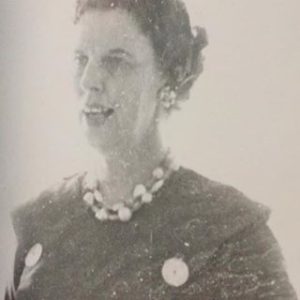 My youngest grandparent – my mom’s mother – was born 100 years ago today. Estella Ryan came into this world, in New Orleans, on the day that Woodrow Wilson was sworn into his second term as U.S. president. Estella – or “Doe” as most people called her, and “Maw” as I and her other eight grandchildren called her – was the third of seven children. I was very close to her until she died just over 20 years ago.
My youngest grandparent – my mom’s mother – was born 100 years ago today. Estella Ryan came into this world, in New Orleans, on the day that Woodrow Wilson was sworn into his second term as U.S. president. Estella – or “Doe” as most people called her, and “Maw” as I and her other eight grandchildren called her – was the third of seven children. I was very close to her until she died just over 20 years ago.
Maw cussed (almost) like a sailor and was quite irreverent. Unlike her children and grandchildren, most of whom were and are very religious, she herself wasn’t so much. She professed the Roman Catholic faith, but – like most of her siblings – was in fact largely indifferent to it and, indeed, to anything spiritual.
Until the last five years of her life – the time she spent without my grandfather (Eddie Gerding), who died in 1991 – she was full of life. And she was the life of all parties, which she loved to attend. At parties, she was usually the center of attention because of her volubility and sharp wit. She had all the bigotries and prejudices of the working-class Irish of her generation. And she was a self-described “yellow-dog Democrat”: she would vote for a yellow dog before voting for a Republican. She believed that FDR and Huey P. Long were saints, and that Edwin Edwards was an excellent governor of Louisiana.
She was so patriotic that she once told me, when I was about 25 years old, that she would be “proud” to have a grandson who died for his country. She was not happy with my reply.
Maw sometimes put on airs. She sometimes acted as if she was wealthier than she was, yet she never crossed the line into financial irresponsibility. She was a loving mother and grandmother – especially, it must be admitted, to me, her oldest grandchild. She doted on me until she died and I, in turn, adored her.
She was born just a few months before John F. Kennedy’s birth.
Of course, Maw and JFK were born into very different families. Maw was the child of a working-class and unknown Irish family in New Orleans; JFK was the child of a wealthy and well-known Irish family in Brookline, Massachusetts. The difference between Maw’s family’s standard of living in 1917 and that of the Kennedys of MA, was, of course, enormous.
But I submit that the difference in 1917 between the living standards of the Ryans of New Orleans and that of the Kennedys of Brookline pales beside the difference between the living standards of the Ryans of New Orleans in 1917 and that of the Ryans’ working-class counterpart in New Orleans in 2017.
Pick any working-class family in New Orleans (or New Iberia, or New York, or New Mexico, or anywhere in the U.S.) today and compare that family’s material standard of living to that of the working-class Ryans of New Orleans a century ago. The difference is huge. Again, this difference is, I am certain, much greater than was the difference between the living standards in 1917 of the Ryans of New Orleans and that of the Kennedys of Brookline.
The working-class Ryans today have, among other luxuries, air-conditioning, antibiotics, affordable household refrigeration, access to vast quantities and varieties of food and clothing, access to 20 or more years of formal education for their children (My grandmother did not graduate from high school, and none of her three children who survived infancy graduated from college), radio, television, laptop computers, the Internet, cell-phones (with a video-calling feature), antidepressant and anti-hypertension medications, contact lenses and Lasik surgery, inexpensive and very safe jet travel (The only foreign country my grandmother ever visited is Canada; she did so once, by car.), and affordable overnight delivery services. The working-class Ryans of 1917 had none of these things. Indeed, the wealthy Kennedys in 1917 had access to only three of these things: post-secondary education, air conditioning, and household refrigeration (and the last two only barely). While the Kennedys in 1917 had better access to food and clothing than did the Ryans of 1917, the range and variety available to the Kennedys in 1917 were far narrower and fewer than are the range and variety open today to the Ryans of 2017.
I’m pretty confident that the Ryans of 1917 did not own a family car, but I can’t be certain that they did not.
Of course, the Kennedys of 2017 can consume more than can the Ryans of 2017. But this difference is almost nothing compared to the differences in the consumption possibilities of the Ryans of 2017 and that of the Ryans of 1917. Indeed, a good case can be made that when Maw died on December 2nd, 1996, she had lived the last twenty or so years of her life at least as materially rich as were – and probably much richer than – the Kennedys of 1917.
Most ordinary Americans today are materially richer than was John D. Rockefeller of a century ago.



